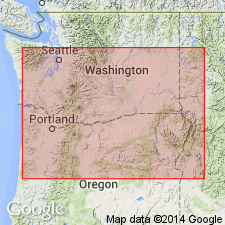
- Usage in publication:
-
- Armstrong Canyon unit
- Modifications:
-
- [Informally named]
- AAPG geologic province:
-
- Eastern Columbia basin
Summary:
Pg. 23 (fig. 1), 39 (table 2), 46-47. Armstrong Canyon unit (informal) in Grande Ronde Basalt of Columbia River Basalt Group. Consists of 2+ flows; glassy to fine-grained, rarely to sparsely plagioclase phyric, and displays entablature/colonnade jointing. Has normal magnetic polarity (is oldest of N2 magnetostratigraphic units). [Confined to southern part of Columbia Plateau.] Lies above Meyer Ridge unit (informal) and lies below and interfingers with Ortley unit (informal); both in Grande Ronde Basalt. [Age is latest early to earliest middle Miocene.]
Named from exposures in Armstrong Canyon, west of town of Condon, central northern OR.
Reference locality: Armstrong Canyon, above confluence with Thirtymile Creek, in south-central part of sec. 3, T. 5 S., R. 19 E., Shoestring Ridge 7.5-min quadrangle, [Gilliam Co.], central northern OR. [Misprint (table 2, p. 39): Armstrong Canyon is west of town of Condon (not south), as stated in text (p. 46).]
[Additional locality information from USGS historical topographic map collection TopoView; accessed September 16, 2013.]
Source: Publication.
For more information, please contact Nancy Stamm, Geologic Names Committee Secretary.
Asterisk (*) indicates published by U.S. Geological Survey authors.
"No current usage" (†) implies that a name has been abandoned or has fallen into disuse. Former usage and, if known, replacement name given in parentheses ( ).
Slash (/) indicates name conflicts with nomenclatural guidelines (CSN, 1933; ACSN, 1961, 1970; NACSN, 1983, 2005, 2021). May be explained within brackets ([ ]).

